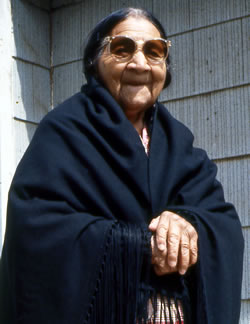 Welcome to Ghost Dance Songs and Religion of a Wind River Shoshone Woman
Welcome to Ghost Dance Songs and Religion of a Wind River Shoshone Woman
My monograph begins with a contextual frame for the songs, including some brief biographical notes about Emily Hill, Wind River Shoshone history, and the larger 1890 Ghost Dance movement. The 76-page book and accompanying pamphlet present seventeen songs (musical and textual transcriptions along with English translations) and quotes all the comments that the women said about the songs and their religious meanings. I analyze the music and the text from many standpoints, and suggest what seem to me to be the aesthetic underpinnings of their artistic expression.
As this monograph is no longer in print, I am making it available to scholars and the general public. It is in PDF format and can be downloaded by clicking the link below. The songs are also available to download as a separate file.
Ghost Dance Songs and Religion of a Wind River Shoshone Woman-Text and Songs.pdf
Ghost Dance Songs and Religion of a Wind River Shoshone Woman-Songs only.pdf
As one Ethnomusicologist at UCLA expressed it, this monograph was the “cocoon” for my later and much larger book, Shoshone Ghost Dance Religion: Poetry Songs and Great Basin Context. Intellectually, this is very true. Emotionally, I shall always have a special attachment to this earlier monograph. It was my first time to experience the beauty of these songs and poetic texts, and the nature religion, which they served. I was smitten by the image of pine tree shadows on a mountain, with butterflies flickering in and out of the dappled sunlight (Song 5).
One can hear Emily and Dorothy, sing Songs 1, 2, 3, and 12 on the Songprints cassette tape, where they appear as Songs 2, 11, 10, and 5 respectively.
Originally published by UCLA Ethnomusicology Publications as a monograph entitled Ghost Dance Songs and Religion of a Wind River Shoshone Woman, c. 1986 U.C. Regents. Reprinted here with permission from UCLA Ethnomusicology Department.
Many Shoshones had advised me to meet Emily Hill, as they felt that she would be a great person to teach me about Shoshone music and culture. I appeared on her doorstep on a July afternoon, and sang for her one of the Shoshone songs I had learned from a record, which I had transcribed before coming to the reservation. She immediately invited me into the bedroom to sing the song for Dorothy Tappay, her half-sister who was an invalid. The sisters smiled at my performance. We talked and they played for me a tape of themselves singing Ghost Dance songs. (See poem) The following December, I taped myself singing one of these songs and sent it as a holiday present to them. This became a tradition, and the seventeen songs that went back and forth between us over six years became the basis for my first monograph published in 1986, Ghost Dance Songs and Religion of a Wind River Shoshone Woman. In this way, Emily became my teacher, and over time, a dear friend.





